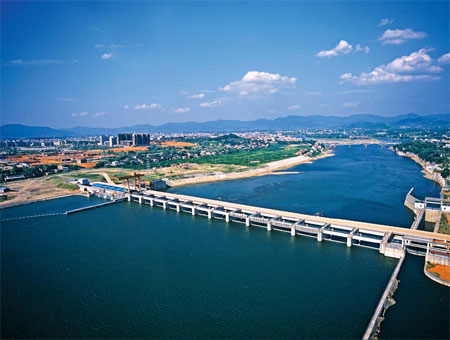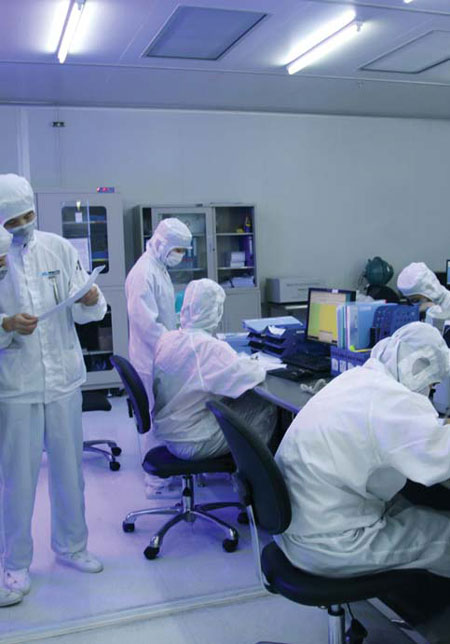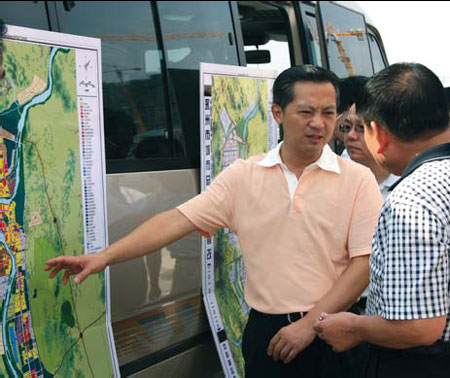|
||||
|
|
||||
Hunan strives to transform economy
By Feng Zhiwei in Changsha ( China Daily )
Updated: 2012-03-31
|
With a history that goes back 2,000 years, Yongzhou is a prefecture-level city in the south of Hunan province. Its total area is 22,441 square kilometers, and it has a population of nearly 5.8 million people. |
|
The laboratory of Hualei Photoelectricity Co Ltd in the city of Chenzhou. |
|
Yongzhou Party chief Zhang Shuofu inspects the city's urban construction. |
|
A night scene in the city of Hengyang, which sits beside the Xiangjiang River, Hunan province's main waterway. |
When Taiwan-based Honghai Group's board chairman Terry Guo was searching for a place to locate the company's new factory, there were many options but one stood out.
"The first time I came to the city of Hengyang in Hunan province, I fell in love with this land within 24 hours," said Guo, whose company is the parent of Foxconn, one of Apple's largest subcontractors.
In August last year, Foxconn opened a new factory in the city. A new industrial cluster focusing on electronic communications is starting to take shape thanks to this factory and the establishment of offices for Omron Corp and ZTE Corp, two leading electronic manufacturing companies in the country.
Growth is being seen in more than just the telecommunications industry. Macao-based New Zhongyuan Group invested 1.2 billion yuan ($190 million) to build a ceramics production base in Hengyang with the goal of rallying the traditional chinaware production industry in the area. Meanwhile, other types of industries are developing rapidly there, including advanced equipment manufacturing, new energy, pharmaceuticals, the chemicals industry and food processing.
In addition to the geographic advantage and human environment in Hengyang, the local government's preferential policies for entrepreneurs are also the key reason for the increasing investment in the place.
Nowadays, a new round of industrial development in eastern coastal China is progressing at a rapid speed.
Zhou Qiang, Party secretary of Hunan province, said the local government should work hard to grasp new opportunities to further open the market and develop better in three ways: creating a good environment, building industrial zones with high-quality facilities and attracting high-end companies.
"Hunan province is a beautiful place with a great natural environment, so during the course of industrial development, environmental protection will be of paramount importance," said Xu Shousheng, governor of Hunan province.
Hengyang has made progress in energy conservation and carbon emissions reductions over the past few years.
The city raised standards for new mining companies to be established and conducted reforms to existed ones to realize a circular economy.
Chenzhou, another rapidly developing city in Hunan province, is also working hard on environmental protection. In the last year, the city spent 100 million yuan to transform an abandoned mine into the city's largest natural park for public use.
Chenzhou and Yongzhou are also developing rapidly during this round of industrial reform in Hunan province.
During the first nine months of 2011, the total area of new factories built in the three cities has reached 4.24 million square meters, accounting for about half the area of the province.
At the same time, the growth rates for the processing trade in the three cities were 114.78 percent, 103.18 percent and 34.89 percent, respectively, a record high.
Chenzhou seeks to become the "most open" city in Hunan province and the central economic hub for a region encompassing the three provinces of Hunan, Guangdong and Jiangxi.
To realize this goal, the city has set up a cooperative relationship with countries in the East Asia, and it is accelerating infrastructure development together with Chenzhou and Hengyang.
Zhou said the three cities will realize a good balance by focusing on their own respective goals.
Hengyang will use its current advantages to focus on developing advanced manufacturing, electronic information technology and modern services industries.
Chenzhou will pay more attention to emerging industries, including nonferrous metals mining and production, new materials, and modern agriculture.
Yongzhou will specialize in high-end equipment manufacturing, agricultural products processing, electronic information, photovoltaic solar product manufacturing, biopharmaceuticals, tourism and textiles.
In Guangdong alone, up to 10,000 companies will potentially relocate in the coming three years, which will create an overall market value of around 1 trillion yuan, according to official figures.
The next three to five years will be a golden period for the industrial transformation of southern China, industrial experts said. The three cities in Hunan province are seeking the chance to attract investments from companies outside of the area at present.
The provincial government of Hunan has laid out a plan for the development of the three cities with the hope of cultivating a series of new industries and strengthening existing ones to increase their competitiveness in the market.
To attract companies in new strategic industries, the managers of industrial zones in the cities are taking measures to complete the fundamental facilities in the area, such as land, logistics, human resources, customs services and energy supply in the zones.
"The customs office in the city of Changsha, capital of Hunan province, promises that we can provide the same priorities and advantages as the customs office in costal provinces," said Li Wenjian, commissioner of Customs of Changsha.
He said the local customs office will work on reducing logistical costs and expanding the preferential policies for companies.
According to the provincial government, its policies treat domestic and foreign companies equally. If they can meet the standards of investment scales required by government regulations, both types of enterprises can get subsidies.
"When potential investors come to Chenzhou, they can go to see the industrial zone and its factories directly and decide whether or not they want to invest here. We provide the related services to the companies, such as residential services for their employees," said Tang Xiaobo, the head of the management department for the processing trade under Commerce Bureau of Chenzhou. "We have learned from the costal region to build high-quality factories that save time for the investors."
"The shortest time for a company to start production is two months after they decide to establish their business here," Tang said.
A new automation industrial park named OMS in Chenzhou is such a case. The company invested 2.8 billion yuan in Chenzhou to build a high-end machinery factory.
The project not only attracted investment but also a whole industrial chain.
To better serve investors, the government has also been working to enhance the traffic infrastructure.
Chenzhou has been focusing on road design and construction in the city.
Moreover, the high-speed railway between city of Wuhan and Guangzhou now stops in Chenzhou, bringing the city into the era of high-speed rail. Now, it can enjoy fast transportation linking it to Hengyang, Yongzhou and the rest of China.
More than 40 companies from the Pearl River Delta region have moved their production operation lines to Chenzhou, thus completing the industrial chain in the area.
As early as 1988, the State Council selected the southern area of Hunan to become a demonstration area for opening up and reform policies.
In October 2011, Hunan province got approval to include Hengyang, Chenzhou and Yongzhou into the demonstration area, which will promote rapid economic development in the future.
fengzhiwei@chinadaily.com.cn
(China Daily 03/31/2012 page12)




